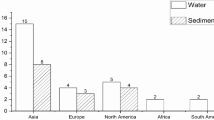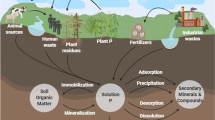Abstract
A popular sequential extraction procedure (Tessier et al. 1979) designed t o extract metals partitioned in various sediment phases, was evaluated for its selectivity. Amorphous FeOOH, FeS, and FeS2 were added separately to natural lake sediments and sequentially extracted. The selectivity of the sequential procedure for the added solid phases was evaluated by determining the difference in the mass of Fe extracted from treated and control sediments. In the experiments where sulfide minerals were added, total S was measured in the residual solids in order to confirm selectivity of the method. Concentrations of total carbon remaining in the solid phase after each extraction step were also measured to determine the selectivity of the sequential procedure for carbon.
The procedure was moderately selective for Fe added as FeOOH; a mean of 77 ± 12% (p < 0.05) of the Fe added was extracted in the step designed to reduce Fe-Mn oxyhydroxides. In experiments where FeS was added, a mean of 69 ± 11% (p < 0.05) of the Fe added as FeS was extracted in the fraction designed to oxidize sulfides and organic matter. Approximately 25% of the Fe added as FeS may have been extracted prematurely. Although less precise, total S analyses confirmed that much of the FeS was extracted in the oxidation step, yielding 104 ± 87% (p < 0.05) of the S added as FeS. The procedure was highly selective for FeS2; 92 ± 14% (p < 0.05) of the Fe added as pyrite was extracted in the sulfide extraction step. Extraction of 80 ± 54% (p < 0.05) of S added as pyrite confirmed that FeS2 were selectively extracted in the sulfide extraction step. Carbon in the sediments was also selectively extracted in the oxidation step (77 ± 2.4% of total C; p < 0.05). The applications and limitations of sequential extraction procedures as limnological research tools are discussed in light of our results.
Similar content being viewed by others
References
Ajayi SO & Vanloon GW (1989) Studies on redistribution during the analytical fractionation of metal in sediments. Sci. Total Environ. 87/88: 171–187
Amaral JA, Hesslein RH & Rudd JWM (1989) Loss of total sulfur and changes in isotopic ratios due to drying of lacustrine sediments. Limnol. Oceanogr. 34: 1351–1358
Belzile N & Tessier A (1990) Interactions between arsenic and iron oxyhydroxides in lacustrine sediments. Geochim. et Cosmochim. Acta 54: 103–109
Belzile N Lecomte P & Tessier A (1989) Testing readsorption of trace metals during partial chemical extractions of bottom sediments. Environ. Sci. Technol. 32: 1015–1020
Campbell PGC & Tessier A (1984) Paleolimnological approaches to the study of acid deposition: metal partitioning in lacustrine sediments. In: Proceeding of a Workshop on Paleolimnological Studies of the History and Effects of Acidic Precipitation (pp 234–274). USEPA CR-811631-01-0
Carignan R (1985) Zinc deposition in acid lakes: the role of diffusion. Science 228: 1524–1526
Carignan R & Tessier A (1988) The co-diagenesis of sulfur and iron in acidic lake sediments of southwestern Quebec. Geochim. Et Cosmochim. Acta 52: 1179–1188
Crosby SA, Glasson DR, Cuttler AH, Butler I, Turner DR, Whitfield M & Millward GE (1983) Surface areas and porosities of Fe (III) - and Fe (II) - derived oxyhydroxides. Environ. Sci. Technol. 17: 709–713
Driscoll CT & Newton RM (1985) Chemical characteristics of acid-sensitive lakes in the Adirondack region of New York. Environ. Sci. Technol. 19: 1018–1024
Driscoll Ct, Fordham GF, Ayling WA & Oliver LM (1989) Short-term changes in the chemistry of trace metals following calcium carbonate treatment of acidic lakes. Can. J. Fish. Aquat. Sci. 46: 249–257
Gubala CP, Engstrom DR & White JR (1990) Effects of iron cycling on210Pb dating of sediments in an Adirondack lake, USA. Can. J. Fish. Aquat. Sci. 47: 1821–1829
Kheboian C & Bauer CF (1987) Accuracy of selective extraction procedures for metal speciation in model aquatic sediments. Anal. Chem. 59: 1417–1423
Lion LL, Altmann RS & Leckie JO (1982) Trace-metal adsorption characteristics of estuarine particulate matter: evaluation of contributions of Fe/Mn oxide and organic surface coatings. Environ. Sci. Technol. 16: 660–666
Martin JM, Nirel P & Thomas AJ (1987) Sequential extraction techniques: promises and problems. Marine Chemistry 22: 313–341
Norton SA (1986) A review of the chemical record in lake sediment of energy related air pollution and its effect on lakes. Water, Air and Soil Pollution 30: 331–345
Nriagu JO & Rao SS (1987) Response of lake sediments to changes in trace metal emission from the smelters at Sudbury, Ontario. Environ. Pollut. 44: 211–218
Rapin F & Förstner U (1983) Sequential leaching techniques for particulate metal speciation: the selectivity of various extractants. Proc. Int. Conference on Heavy Metals in the Environment, Heidelburg. CEP Consultants, Eds., Edinburgh, 1074–1077
Rapin F, Tessier A, Campbell PGC & Carignan R (1986) Potential artifacts in the determination of metal partitioning in sediments by a sequential extraction procedure. Environ. Sci. Technol. 20: 836–840
Tessier A & Campbell PGC (1988) Comments on the testing of the accuracy of an extraction procedure for determining the partitioning of trace metals in sediments. Anal. Chem. 60: 1475–1476
Tessier A, Campbell PGC & Bisson M (1979) Sequential extraction procedure for the speciation of particulate trace metals. Anal. Chem. 51: 844–851
Tessier A (1980) Trace metal speciation in the Yamaska and St. François Rivers (Quebec)Can. J. Earth Sci. 17: 90–105
Tessier A (1982) Particulate trace metal speciation in stream sediments and relationships with grain size: Implications for geochemical exploration. J. Geochem. Explor. 16: 77–104
Tessier A, Carignan R, Dubreuil B & Rapin F (1989) Partitioning of zinc between the water column and the oxic sediments in lakes. Geochim. et Cosmochim. Acta 53: 1511–1522
White JR, Gubala CP, Fry B, Owen J & Mitchell MJ (1989) Sediment biogeochemistry of iron and sulfur in an acidic lake. Geochim. Cosmochim. Acta 53: 2547–2559
White JR & Gubala CP (1990) Sequentially extracted metals in Adirondack lake sediment cores. J. Paleolimnology 3: 243–252
Author information
Authors and Affiliations
Additional information
Request for offprints
Rights and permissions
About this article
Cite this article
Shannon, R.D., White, J.R. The selectivity of a sequential extraction procedure for the determination of iron oxyhydroxides andiron sulfides in lake sediments. Biogeochemistry 14, 193–208 (1991). https://doi.org/10.1007/BF00000807
Accepted:
Issue Date:
DOI: https://doi.org/10.1007/BF00000807




